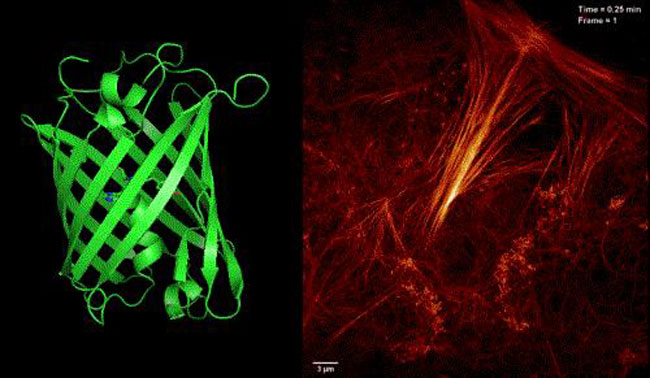A novel protein with a fluorescent probe for imaging live cells could improve live-cell superresolution (SR) imaging. While the use of reversibly switchable fluorescent proteins (RSFPs) reduces illumination intensity and thus enables SR imaging of live cells, existing RSFPs are limited by their small number of switching cycles, low fluorescence signal and poor contrast.

Schema: Skylan-NS and live-cell SR imaging of actin structures. Courtesy of the Institute of Biophysics (IBP), CAS.
To achieve a more desirable resolution in live-cell SR imaging, researchers at the Institute of Biophysics and the Howard Hughes Medical Institute developed a monomer, called RSFP Skylan-NS (sky lantern for nonlinear structured illumination), and applied it to their previously developed SR imaging technique, called Patterned Activation Nonlinear SIM (PA NL-SIM).
PA NL-SIM uses RSFPs for noninvasive live-cell imaging. However, the suitability of these RSFPs for the PA NL-SIM technique had never been examined.
The researchers compared the photophysical properties of Skylan-NS against two other RSFPs – rsEGFP2 and Dronpa. They further measured and evaluated the imaging performance of all three RSFPs when applied to PA NL-SIM.
Live-cell NL-SIM imaging of Skylan-NS–Lifeact. Courtesy of the Institute of Biophysics (IBP), CAS.
The research team demonstrated that Skylan-NS was superior to the other two RSFPs in its photostability, cycle numbers and signal-to-noise ratio. Using Skylan-NS, they achieved low-energy (100 W/cm2), high-sampling speed (sub-second level), high-resolution (~ 60 nm), and long-term (~30 point in time) superresolution imaging in living cells.
The results of the study show that the fluorescent protein Skylan-NS enables substantial improvements in the speed, duration and noninvasiveness of live-cell SR microscopy.
The research was published in Proceedings of the National Academy of Sciences (doi:10.1073/pnas.1611038113).